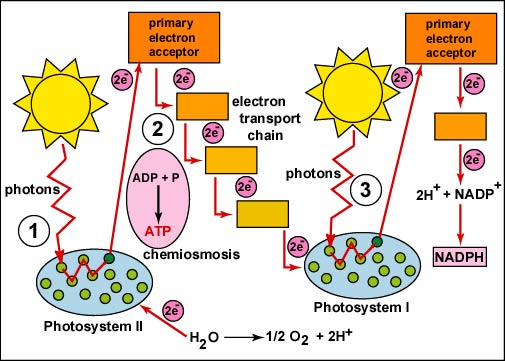Mollie, Julian, and Christie
Light Reactions - Photosystem II
- Molecules involved in INPUT: Light, H2O
- No major enzymes
- Molecules in OUTPUT: 2 electrons, ATP
- Main objective of this stage/process
- To provide electrons for photosynthesis
- To produce ATP once it goes down the ETC
- Elaboration
- P680 molecules (described as wavelengths that represent when they absorb the most amount of light) are certain types of chlorophyll molecules that absorb energy in this process.
- When electrons that are trapped by P680 molecules get excited, they are released.
Light Reactions - Photosystem I
- Molecules involved in INPUT: light
- Major enzymes: NADPH (a coenzyme)
- Molecules in OUTPUT: 2 electrons, NADPH (energy-rich molecule)
- Main objective of this stage/process
- To move electrons into the Calvin Cycle to complete photosynthesis
- Elaboration
- If not enough ATP is produced, the electrons will move back into Photosystem I by the cyclic cycle
- If there is enough ATP, this starts the noncyclic cycle, which moves into the Calvin Cycle
Calvin Cycle - Phase I Carbon Fixation
- Molecules involved in INPUT: 6 molecules of CO2 per cycle, energy from NADPH, energy from ATP
- No major enzymes
- Molecules in OUTPUT: glucose, ADP, NADP+
- Main objectives of this stage/process
- To produce glucose
- Elaboration
- The Calvin Cycle is a light-independent reaction. This means that it does not directly need light to perform, but light must be present in order for it to perform (light comes in through phosphorylation)

http://www.biologycorner.com/resources/photosystem.jpg
^ Photosystem I and II ^

http://library.thinkquest.org/C004535/media/calvin_cycle.gif
^ The Calvin Cycle ^
No comments:
Post a Comment